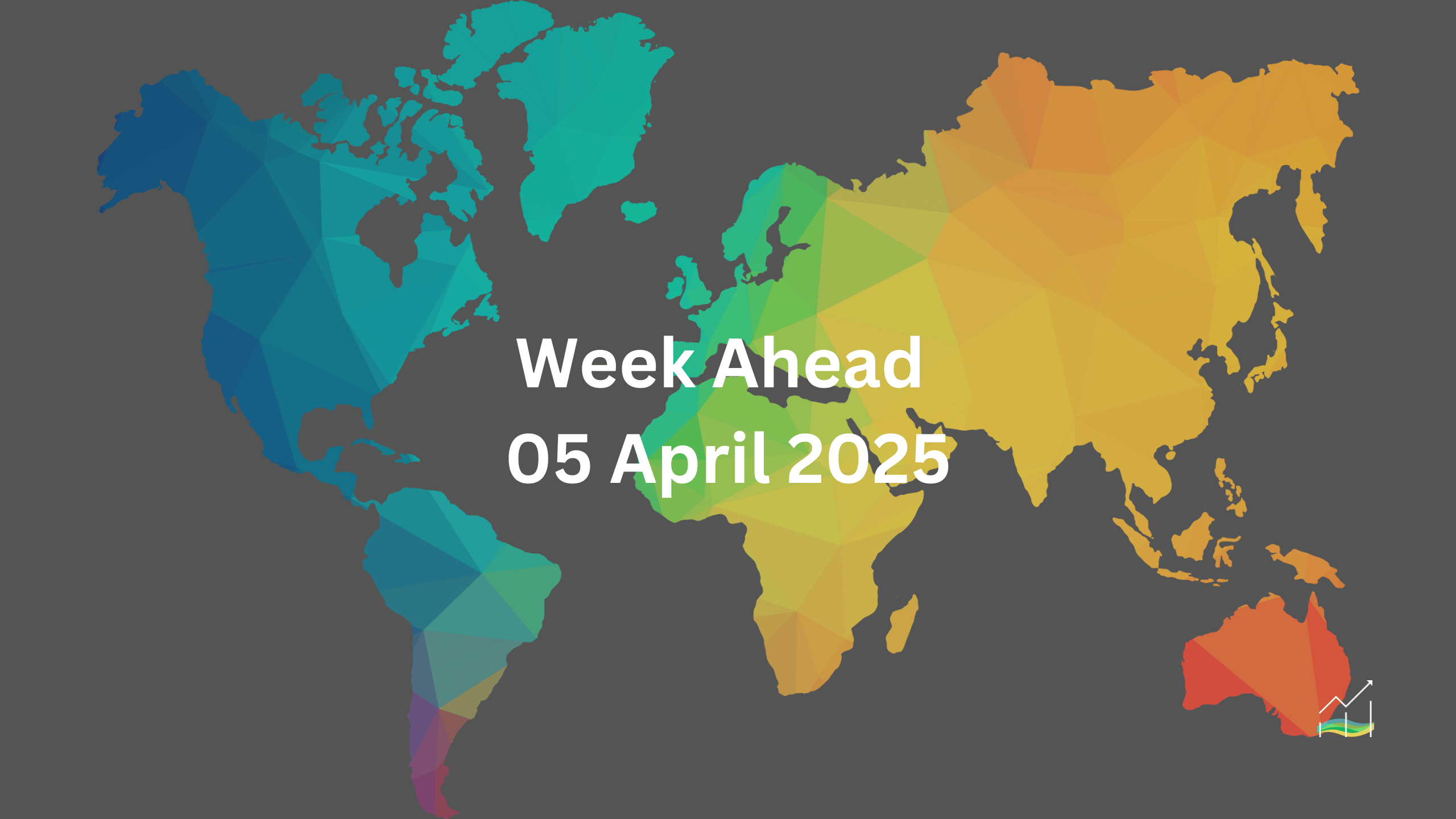05/04/2025 Week Ahead

Trade Tensions Escalate as Inflation Data Moves Into Focus
Key Takeaways:
- Major market volatility triggered by sweeping U.S. tariffs and China's sharp retaliatory actions.
- Upcoming U.S. inflation data and Fed minutes could shape expectations for future rate decisions.
- China's latest CPI and PPI figures to reveal the impact of domestic stimulus measures.
- Fed Chair Powell signaled little support for immediate intervention despite market losses.
Markets face another turbulent week as the aftershocks of sweeping U.S. tariffs ripple across global economies. The announcement by President Trump to impose broad-based import tariffs triggered a dramatic downturn in equities, bond yields, and the U.S. dollar. China’s aggressive response—including higher tariffs and restrictions on rare earth exports—has intensified fears of a full-scale trade war.
This geopolitical shift marks a potential inflection point. While the dollar remains the dominant reserve currency, the U.S.’s posture suggests a retreat from its traditional leadership role in global trade, creating long-term uncertainty. Canada and Mexico, though spared from immediate retaliation, are now actively seeking to diversify their trade dependencies.
Attention now shifts to key economic data that could influence monetary policy. In the U.S., consumer inflation and the University of Michigan’s sentiment survey will be closely watched for signs of economic strain. The Federal Reserve’s meeting minutes will offer insight into internal policy thinking, though Fed Chair Powell recently pushed back on expectations for imminent rate cuts—despite significant equity losses.
In Asia, China’s inflation data is anticipated to confirm an exit from deflation. While stimulus efforts have supported domestic demand, the broader trade conflict may still elevate costs and dampen growth. Market participants will also closely monitor the Reserve Bank of New Zealand’s policy stance as global financial dynamics shift under the weight of trade protectionism.
The volatility of the past week—highlighted by an 11% drop in the S&P 500 and a 12.5% plunge in the Nasdaq—raises key questions about market tolerance and the administration’s pain threshold. With the Fed signaling it won’t step in immediately, investors are left to assess whether further declines will force political or policy recalibration.
United States of America
Overview
The U.S. faces growing economic uncertainty as trade tensions escalate and the effects begin to ripple through sentiment, inflation expectations, and monetary policy outlook. Despite President Trump’s willingness to tolerate short-term economic pain in pursuit of longer-term strategic goals, markets are beginning to price in a sharp slowdown in growth. The week ahead is packed with critical inflation data and FOMC minutes, which could shape expectations for the Fed’s next move.
Economic Drivers
- Rising trade tensions are creating conflicting pressures: higher prices and weaker growth.
- President Trump's focus shift from stock markets to bond yields signals tolerance for economic disruption.
- Tariffs risk reducing corporate profit margins and consumer spending power.
- Financial markets now expect over 100 basis points of Fed rate cuts by year-end.
- Surveys show growing concern over inflation, but market-based inflation expectations remain subdued.
- Potential for the Fed to activate the "Fed put" if equity markets continue falling and growth weakens.
Data and Events
- April 10, 2025 – FOMC Meeting Minutes: Investors will be looking for clues on the Fed’s internal debate around inflation and the transitory effects of tariffs.
- April 11, 2025 – Consumer Price Index (March): Headline CPI expected to rise 0.1%, slowing annual rate to 2.6%. Core CPI may rise 0.3%, with annual core inflation easing to 3.0%.
- April 12, 2025 – Producer Price Index (March): Headline PPI expected at 0.2% MoM, lifting annual to 3.3%. Core PPI may rise 0.3%, taking the annual rate to 3.4%.
- April 12, 2025 – Federal Budget Balance (March): Too early to reflect federal layoffs; muted impact expected for now.
- April 12, 2025 – University of Michigan Sentiment Survey (Prelim April): Will gauge how much consumer confidence has been hit by the new tariff regime.
- April 8–10, 2025 – Treasury Auctions:
- April 8 – $58 billion in 3-year notes
- April 9 – $39 billion in 10-year notes
- April 10 – $22 billion in 30-year bonds
Price Action
- The Dollar Index is trading with strong momentum above 103.00, following a sharp weekly close.
- Last Thursday’s range (approx. 101.25–103.40) may serve as the key technical band for upcoming moves.
- Breakeven inflation rates remain low despite CPI concerns, with 5-year near 240bp and 10-year near 220bp.
- Equities continue to face downward pressure, raising the probability of a policy response if declines deepen.
Key Points:
- Trade war impact is being felt through weaker growth and potential inflation risks.
- Markets are beginning to fully price in multiple Fed rate cuts for 2025.
- Critical CPI and PPI readings will influence how policymakers view inflation persistence.
- Fed minutes could reveal how seriously the committee is considering pre-emptive rate action.
- Dollar remains firm, while consumer sentiment and equity markets are showing strain.
Australia & New Zealand
Overview
Both Australia and New Zealand enter the week under heightened scrutiny as global markets reel from escalating trade tensions and mounting fears of recession. Central banks in both countries are facing growing pressure to respond to external shocks, especially as their currencies come under heavy selling. With no major domestic data scheduled in Australia, attention turns to a pivotal speech by RBA Governor Michele Bullock and the RBNZ’s upcoming policy decision. Volatile market conditions and policy signals will dominate sentiment in the days ahead.
Economic Drivers
- Rising trade tensions and weakening global growth are raising pressure on central banks in both countries.
- In Australia, the RBA faces criticism for not considering a rate cut at its recent meeting despite clear downside risks.
- Domestic banks are increasingly pricing in a 50-basis-point cut by May and further easing later in the year.
- In New Zealand, the RBNZ has already delivered three consecutive 50-basis-point cuts, bringing the cash rate to 3.75%.
- New Zealand’s economy contracted in Q2 and Q3 last year but rebounded 0.7% in Q4; CPI stood at 2.2% YoY in Q4 2024.
- Market pricing indicates further RBNZ cuts are likely but possibly more gradual than earlier in the cycle.
Data and Events
- April 9, 2025 – RBNZ Policy Decision: A 25bp rate cut is expected, though commentary around global risks may have a stronger market impact than the rate move itself.
- April 11, 2025 – Speech by RBA Governor Michele Bullock: Traders will look for the RBA’s stance on global slowdown risks and reasons behind its recent policy inaction. Potential clues about future cuts will be closely analyzed.
Price Action
- AUD/USD plunged to $0.5985, the lowest level since early 2020, following a broad risk-off move. It ended last week down over 4.2%, the steepest weekly decline since October 2008.
- The Australian dollar finished nearly four standard deviations below its 20-day moving average (~$0.6010), indicating a potentially overextended drop.
- A retest of support near $0.6200 is plausible, but further weakness could target the March 2020 Covid-low around $0.5500.
- Correlations remain high: AUD moves closely with USD (0.75 correlation) and CAD (0.80), reflecting risk sentiment and commodity price links.
- NZD similarly remains vulnerable to external volatility, though less oversold than the AUD on a technical basis.
Key Points:
- RBA faces growing criticism for not responding to worsening global risks.
- Bullock’s speech may offer forward guidance on potential rate cuts.
- AUD saw its sharpest drop since 2008, pointing to possible technical rebound.
- Market pricing now reflects expectations for a 50bp rate cut from RBA in May.
- RBNZ expected to deliver another 25bp cut amid global uncertainty.
- Economic rebound in Q4 gives some room, but CPI and growth remain soft.
- NZD remains vulnerable to external volatility and further policy easing.
- Traders will closely watch the RBNZ’s tone on global risks post-decision.
Canada
Overview
The Canadian dollar is caught between shifting U.S. yield dynamics, market volatility, and domestic economic concerns. With the U.S. trade war weighing on global growth and risk sentiment, correlations have shifted notably—especially the relationship between USD/CAD and U.S. yields. While Canada was spared from direct reciprocal tariffs, its economic exposure to the U.S. remains high. This week, local attention turns to key sentiment surveys and positioning ahead of the Bank of Canada’s upcoming meeting.
Economic Drivers
- USD/CAD is now more sensitive to short-term U.S. interest rates, with the 30-day inverse correlation to the 2-year yield reaching -0.50, the strongest since early 2020.
- Broader risk sentiment continues to influence CAD, though correlation with the S&P 500 has weakened from 0.50 to near 0.10.
- Canada’s economy is vulnerable to the spillover effects of the U.S. trade war, increasing the risk of recession.
- The Bank of Canada began easing well before recent global turmoil; markets are now pricing in deeper cuts by year-end.
- Swaps markets show the expected year-end policy rate falling to around 2.25% from an earlier projection of just under 2.65%.
Data and Events
- April 8, 2025 – Ivey PMI (March): A key indicator of Canadian business activity and private sector sentiment.
- April 12, 2025 – Bank of Canada Business Outlook Survey: Will offer insights into corporate expectations amid growing economic risks.
Price Action
- USD/CAD dropped to CAD1.4025 last week, its lowest since December, during the broader U.S. dollar sell-off.
- The Canadian dollar briefly benefited from Canada avoiding direct retaliatory tariffs, but momentum reversed following a weak jobs report.
- USD/CAD surged to CAD1.4255 on Friday, posting its biggest single-day gain of the year (~0.95%) and ending a three-day losing streak.
- Near-term resistance is seen around CAD1.4315–1.4325.
- Correlation with the Dollar Index remains strong (30-day correlation at 0.58), after dipping below 0.20 in early February—the lowest since August 2023.
Key Points:
- USD/CAD now reacts more closely to U.S. 2-year yield changes, a notable shift from prior years.
- Risk of Canadian recession grows as trade war intensifies and U.S. economic weakness spreads.
- Market pricing increasingly reflects the likelihood of more BoC cuts in June and beyond.
- This week’s Ivey PMI and BoC Survey may influence expectations ahead of the April 16 policy meeting.
- USD/CAD technical setup shows potential for further upside if risk sentiment remains weak.
China
Overview
China enters the week with rising inflation expectations, mounting geopolitical tensions, and a currency under pressure. Markets are focused on Thursday’s CPI and PPI data, which could confirm a rebound from deflation while keeping producer prices in contraction. Ongoing trade retaliation against the U.S., including tariffs, product bans, and rare earth restrictions, raises the stakes. Meanwhile, the People’s Bank of China appears to be shifting toward tolerance of a weaker yuan, a move that may signal more flexibility in the face of global pressure.
Economic Drivers
- Persistent deflation continues to challenge domestic consumption and demand recovery.
- Policymakers face constraints in delivering monetary easing due to pressure on the yuan.
- Expectations are growing for more fiscal and targeted stimulus as traditional rate cuts risk accelerating capital outflows.
- The PBOC appears to be allowing more exchange rate flexibility, setting the dollar reference rate at the highest level this year.
- U.S.-China trade tensions are escalating, with China imposing 34% tariffs on all U.S. imports and announcing more export restrictions on rare earths.
- Geopolitical tensions are rising, especially around Taiwan, adding to market uncertainty.
Data and Events
- April 10, 2025 – Consumer Price Index (March): CPI expected to rebound from -0.7% YoY, indicating an exit from deflation.
- April 10, 2025 – Producer Price Index (March): PPI likely to remain in contraction, reflecting ongoing industrial weakness.
- April 8–12, 2025 – New Yuan Lending (March): May offer clues on domestic credit conditions, though CPI and PPI remain the main focus.
Price Action
- The offshore yuan (CNH) traded in a wide range between 7.24 and 7.35 last week, ending higher for the third consecutive week.
- The PBOC’s daily USD fix shifted more than usual, with Friday’s fix marking the highest level of 2025 so far—suggesting tolerance for yuan weakness.
- Correlation between USD/CNH and the Dollar Index has weakened from ~0.75 to ~0.50, reflecting changing dynamics.
- Correlation with the yen has also dropped sharply (~0.45 to <0.20), signaling divergence from broader Asian FX trends.
- Market sentiment suggests the yuan may drift weaker unless actively defended, especially if inflation rebounds modestly and monetary easing remains constrained.
Key Points:
- CPI and PPI on April 10 will be closely watched for confirmation that China is emerging from deflation.
- Tariff retaliation has intensified, raising risks of further economic and geopolitical escalation.
- PBOC appears increasingly tolerant of a weaker yuan as it balances deflation control and trade retaliation.
- Correlation with broader FX benchmarks has weakened, highlighting shifting capital flow and policy dynamics.
- Yuan remains vulnerable as external risks rise and domestic policy options narrow.
Europe
Overview
The eurozone is navigating the early effects of U.S. trade tariffs, with the shock acting as a headwind to growth, though partly cushioned by defense and infrastructure spending and signs of economic recovery. While some high-frequency data are due, the broader geopolitical and macroeconomic context remains the dominant force shaping market sentiment. Despite a light calendar, attention will remain on the ECB's upcoming decision, geopolitical tensions, and capital flows out of U.S. equities by European investors.
Economic Drivers
- The trade war is creating uneven pressure across the eurozone, but spending in key sectors and early signs of recovery are cushioning the blow.
- Defense and infrastructure-related spending could support medium-term growth.
- European investors appear to be unwinding record U.S. equity purchases made last year.
- The ECB is widely expected to cut rates at the April 17 meeting; market-implied odds stand near 85%.
- Monetary policy reaction is more likely to be shaped by the broader economic outlook than this week’s data.
Data and Events
- April 8, 2025 – Germany Foreign Trade and Industrial Production (February): Key read on export performance and factory output amid external shocks.
- April 8, 2025 – Eurozone Retail Sales (February): Provides insight into consumer activity across the bloc.
- April 9, 2025 – Germany Green Bund Auction: €3 billion February 2035-dated twin of existing nominal issue.
- April 10, 2025 – Italian Industrial Production (February): Gauges Italy’s industrial resilience in light of global headwinds.
- April 11, 2025 – German and Spanish CPI (Final March Readings): Will confirm if inflation pressures are aligning with ECB expectations.
- April 11, 2025 – France Current Account (February): Offers a snapshot of external balances.
- April 11, 2025 – German Joint Economic Forecast: May attract increased attention amid trade uncertainty and fiscal stimulus plans.
- April 8–11, 2025 – Sovereign Bond Auctions:
- April 8 – Netherlands, Austria
- April 9 – Portugal
- April 10 – Spain
- April 11 – Italy
Price Action
- The euro gained 1.2% last week, marking its fourth weekly rise in five, though it pulled back from highs.
- Price action suggests likely consolidation early in the week following last Thursday’s wide range (~$1.0800–$1.1145).
- EUR/USD closed near highs from March and November; failure to hold above $1.0900 may trigger liquidation of long positions.
- Since bottoming in early February near $1.0140, the euro has rallied nearly 10%; a 38.2% retracement of this move lies near $1.0760.
- Markets are cautious ahead of the ECB decision, with traders pricing in a cut but remaining sensitive to macro headlines.
Key Points:
- Trade war impact is uneven but buffered by spending and early economic recovery.
- ECB expected to cut rates April 17; data may have limited influence on this outcome.
- Capital outflows from U.S. equities suggest a shift in European investor sentiment.
- Light data week puts focus on broader risks, ECB tone, and geopolitical developments.
- EUR/USD faces potential technical pressure below $1.0900; consolidation likely.
Japan
Overview
The yen remains heavily influenced by shifts in U.S. Treasury yields, with recent price action reflecting this dynamic. Despite the Bank of Japan’s tightening stance, the yen's behavior is more aligned with changes in U.S. 10-year yields than yield differentials, indicating the dominant role of U.S. monetary policy. A strong seasonal current account surplus is expected this week, but structural trade deficits remain. Focus will also be on BOJ commentary and regional economic conditions amid increasing speculation about the timing of future rate hikes.
Economic Drivers
- Yen’s movements remain strongly tied to U.S. 10-year yield fluctuations rather than US-Japan 10-year rate differentials.
- The BOJ is in a gradual tightening phase, while the Fed is on pause in its easing cycle, making cross-market relationships more complex.
- Japan continues to post a current account surplus (~4.8% of GDP in 2024), but this is primarily driven by investment income, not trade.
- On a balance-of-payments basis, Japan hasn't posted an annual trade surplus since 2021.
- The BOJ’s quarterly regional economic report and Ueda’s speech may offer insight into wage trends and inflation pressures, which are crucial to the policy path.
Data and Events
- April 8, 2025 – BOJ Branch Managers Meeting & Regional Economic Report: Focus on inflation pass-through and wage developments.
- April 8, 2025 – Current Account Balance (February): A large surplus is expected, continuing a decades-long seasonal pattern of improvement from January.
- April 9, 2025 – BOJ Governor Ueda Speech: Remarks will be watched for signals on the next rate hike timeline.
- April 10, 2025 – Bank Lending (March): Reflects credit demand and private sector momentum.
- April 8, 2025 – 30-Year JGB Auction: ¥800 billion issuance; expected strong interest from insurers and pension funds.
- April 10, 2025 – 5-Year JGB Auction: ¥2.4 trillion issuance; closely watched as yield dynamics shift.
Price Action
- USD/JPY dropped from 150.50 to 144.55 last week, its lowest level since October, following a steep decline in U.S. yields.
- A partial rebound followed the U.S. jobs report, lifting USD/JPY to around 147.50 before sellers returned.
- This was the fourth time in nine weeks that the dollar fell more than 1.7% against the yen.
- Three-month implied volatility spiked to 12% last week, the highest in six months, up from 9.7% in late March.
- Momentum remains yield-driven, but increased volatility points to rising uncertainty around rate expectations.
Key Points:
- USD/JPY remains highly sensitive to changes in U.S. 10-year yields.
- A strong current account surplus is expected, but underlying trade dynamics remain weak.
- BOJ’s regional economic report and Ueda’s speech may provide direction on future tightening.
- Bond auctions this week could offer insight into institutional appetite amid shifting yield expectations.
- Elevated volatility suggests increased sensitivity to rate outlooks and external developments.
Switzerland
Switzerland will hold its monthly bond auction on Wednesday.
United Kingdom
Overview
The UK enters the week with hopes for a modest economic rebound, as February GDP data is expected to show a recovery from January’s surprise contraction. While domestic fiscal support continues to provide a growth buffer, weakening activity in the U.S. and eurozone threatens to create drag later in the year. Sterling has shown extreme sensitivity to U.S. rate moves and broader dollar direction, while trade data and industrial production will help refine growth expectations heading into Q2.
Economic Drivers
- UK government is ramping up fiscal spending, offering some support to growth through 2025.
- Sluggish external demand from the U.S. and eurozone may become a headwind in the second half of the year.
- Sterling remains highly sensitive to U.S. two-year yield changes (rolling 30-day correlation of ~0.30), far more than to UK Gilts (~0.15).
- Historically strong inverse correlation with the Dollar Index (~-0.88), underscoring dollar dominance over GBP trends.
- Sterling has also weakened significantly against the euro, with EUR/GBP rallying to its highest since August 2023.
Data and Events
- April 8, 2025 – Halifax House Price Index (March): Offers an update on the housing market, which has shown signs of renewed volatility.
- April 9, 2025 – Gilt Auction (March 2030): Market interest in mid-duration paper will be monitored.
- April 10, 2025 – Gilt Auction (July 2054): Demand for long-end gilts may reflect inflation and growth expectations.
- April 11, 2025 – GDP (February): Forecasted rebound after January’s -0.1% surprise contraction.
- April 11, 2025 – Industrial Production (February): A potential bounce back from January’s -0.9% drop; focus will be on manufacturing.
- April 11, 2025 – Trade Balance (February): Especially relevant after January’s first surplus (ex-precious metals) since June 2021; gold flows may distort figures.
Price Action
- GBP/USD spiked to $1.32 following U.S. tariff headlines but quickly reversed, breaking through $1.2950 and falling to a low near $1.2860—a new low since early March.
- Sterling has rallied significantly from mid-January’s low near $1.2100 but now shows signs of a technical correction.
- Momentum indicators remain pointed lower, with the next support zone between $1.2785–$1.2815.
- EUR/GBP has surged ~2% in the past two sessions to ~GBP0.8520, its highest level since August 2023.
- GBP strength may continue to be undermined by euro resilience despite the eurozone facing deeper tariff impacts.
Key Points:
- February GDP is expected to show mild recovery; January’s data surprised to the downside.
- Sterling is heavily driven by U.S. rate expectations and broader dollar moves, not domestic rate spreads.
- EUR/GBP has gained sharply, suggesting relative weakness in GBP despite UK avoiding heavier tariff exposure.
- Manufacturing and trade data could influence growth trajectory and policy expectations.
- Technical pressures point to further downside in GBP/USD if $1.2785 support is tested.
© 2025 SKONE Enterprise (003319453-V). All rights reserved.
The content on this site is for informational purposes only and does not constitute financial advice.


